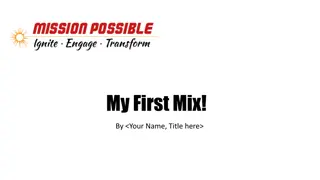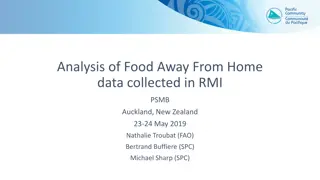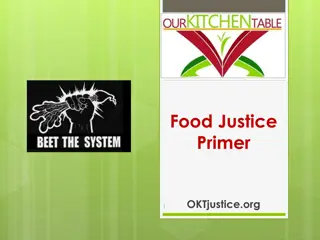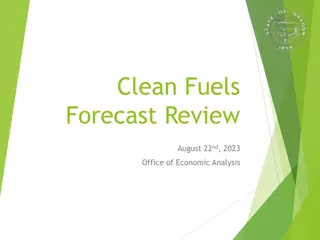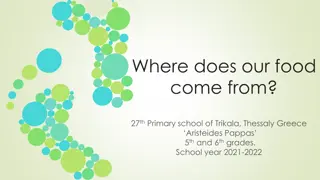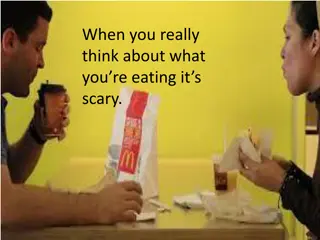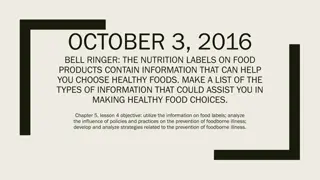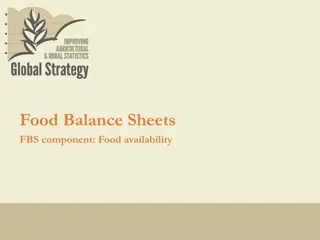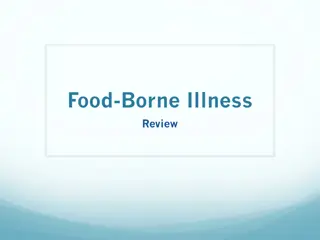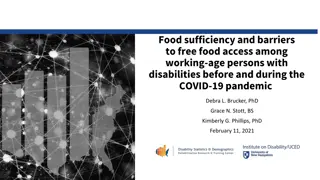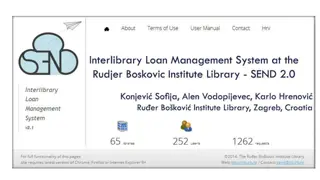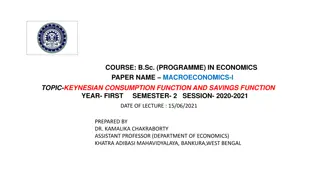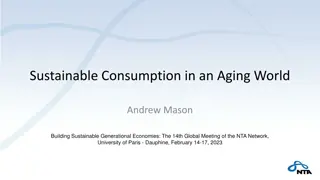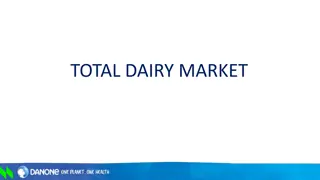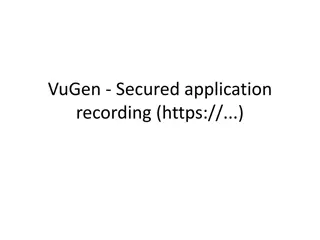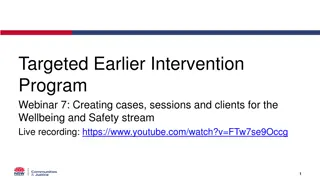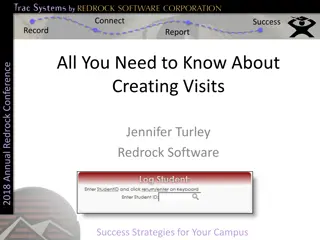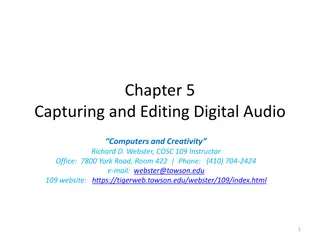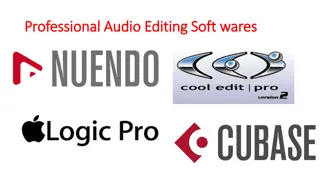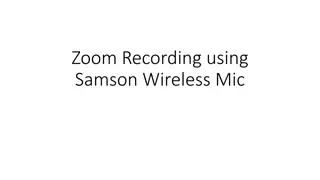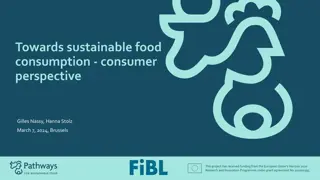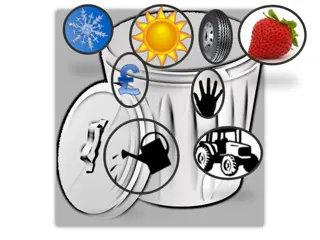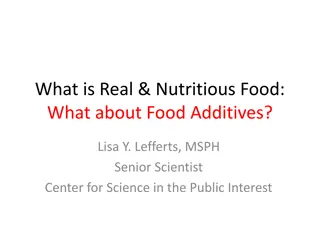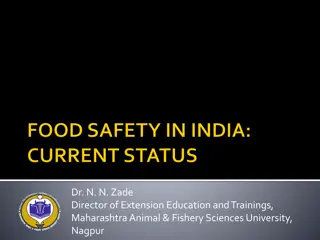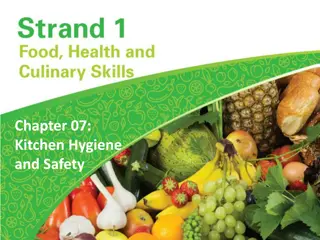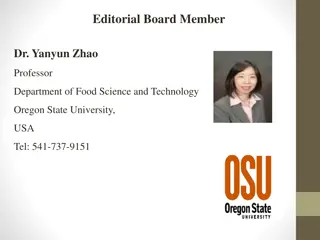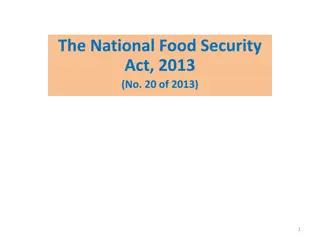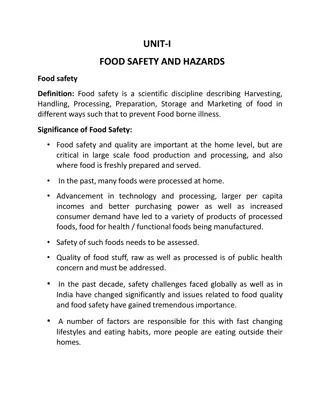Streamlining Food Consumption Recording Process in F&B Department at Sitaram Bhartia Institute
Effective management of food consumption is crucial for the success of hospitals. This project aims to design a system to streamline the recording of food consumption in the F&B department at Sitaram Bhartia Institute of Science and Research. By collecting data from various categories like in-patients, staff cafeteria, coffee shop, and official events, this initiative seeks to improve inventory management and cost-effectiveness. The study focuses on creating systematic formats to collect baseline data, such as the IPD Daily Consumption Sheet and Staff Cafeteria Food Tracker Sheet.
Download Presentation

Please find below an Image/Link to download the presentation.
The content on the website is provided AS IS for your information and personal use only. It may not be sold, licensed, or shared on other websites without obtaining consent from the author. Download presentation by click this link. If you encounter any issues during the download, it is possible that the publisher has removed the file from their server.
E N D
Presentation Transcript
STREAMLINING THE RECORDING PROCESS OF FOOD CONSUMPTION FOR F& B DEPARTMENT IN SBISR Submitted by ~ Dr. Rakhi Wadhwani PG/072/2012 Enrollment No. ~
ORGANISATION PROFILE Sitaram Bhartia Institute of Science and Research is a paradigm a human institution put together, being constantly improved and honed into maturity by a team of professionals committed to excellence in health care. From its roots in epidemiological research, today Sitaram Bhartia functions as a multi-specialty hospital and research center. Core Purpose To serve society as a well-spring of excellence in healthcare delivery, research and education. Core Values Putting the interest of the patient first Treating others as you would want to be treated yourself Continuous learning and improvement Institution building Envisioned Future Hospital will be a prolific medical center that will be known for its commitment to practicing evidence-based medicine and providing world-class care. Hospital will have well established research programs that will focus on gaining a better understanding of the health care needs in our communities and developing practical solutions for addressing those needs. We will be seen as pioneers who will have successfully taken up those health care challenges that may otherwise have remained poorly addressed. We will have collaborative arrangements with leading institutions from around the world and be in the forefront of providing training to health professionals.
INTRODUCTION Effective hospital management is the crux of success in the ever changing and dynamic world of today. Today world is realizing the importance of F & B management in hospitals.[2]India is the developing country and even the health industry in India is growing rapidly. To be in the competition with the international hospitals Indian hospitals must have increased its standards in all the major areas. Out of these F & B has turned out to be a recognized support service which not only ensures prevention and containment of hospital infection but also contributes to widen the image of the hospital in the eyes of public.[7] Streamlining the F & B department is must for that we consumption data through this project which can ultimately be linked to the inventory management in future as it is necessary to be the cost effective. To collect the base line data for management of F & B department it is necessary to know the total food consumption of the hospital. The data related to F & B department use to be collected but not in a systematic way. So designing of proper format and system is needed so as to get the appropriate baseline data. New Formats are designed to get the food consumption data in 4 main categories i.e. IN-PATIENTS, STAFF CAFETERIA, COFFEE SHOP AND OFFICIAL EVENTS. New excel sheets are made to get the data in respective categories. need the food
AIM & OBJECTIVE AIM OFTHE STUDY ~ To systemizing the process of recording food consumption for F & B department of Sitaram Bhartia Institute of Science & Research. SPECIFIC OBJECTIVE ~ To design a system for recording the food consumption in F & B department of Sitaram Bhartia Institute of Science & Research. To systemize the process of recording of food consumption in F & B department of Sitaram Bhartia Institute of Research Science. To collect the data for daily food consumption in IPD, through the tracker sheet named IPD Daily Consumption sheet . To collect the data for extra orders given by in-patients (with meal or as random orders), through the tracker sheet named IPD - Extra order Food Consumption sheet (apart from 8 served meals). To collect the data for food consumption in Staff Cafeteria, through the tracker sheet named Staff Cafeteria - Food Consumption sheet . To collect the data of food consumption in Official Events, through the tracker sheet named Official Events - Food Consumption Sheet . To collect the data for food consumption in coffee shop, through the tracker sheet Coffee Shop Food Consumption Sheet.
RATIONALE In Sitaram Bhartia Institute of Research Sciences the food consumption data was recorded but not in systemize format. So there was no baseline data. Streamlining the F & B department is must for that we need the food consumption data through this project which can ultimately be linked to the inventory management in future as it is necessary for being cost effective. To collect the base line data for management of F & B department it is necessary to know the total food consumption of the hospital. Once we get the baseline data of total food consumption in the hospital we can improvise in many ways for making F & B Management effective as well as efficient. This data can also be useful for inventory management. Thus it is very necessary to collect credible food consumption data.
LITERATURE REVIEW The study on Future Skills Requirements of the Food and Beverage Sector was done by Expert Group ON Future Skill Need in November 2009 to review current and future skills demand and supply for the food and beverage sector and to identify the current and future key drivers of change. The methodology for this report included three main phases, namely: Phase 1 Secondary Research and identification of Drivers-of- change; Phase2 Primary Research and Consultations; and Phase 3 Conclusions, Recommendations and Reporting. The result of the study was that six key drivers-of- change in the sector were identified i.e. consumer trends; health and wellness; sustainability and ethical concerns; policy; consolidation of retailers; and technology. Companies need to become more aware of what is currently being provided by the third level institutions and development agencies and to engage with, and participate in, these courses, initiatives and programs.[3] The study titled Hospital foodservice directors identify the important aspects when implementing room service in hospital foodservice was conducted by Zafirah Mohd at Nor Iowa State University Ames, Iowa in 2010. A mixed methods design was used which included an in-depth interview with a key informant (an expert) was conducted to collect detailed and rich data about room service implementation. The findings propose the need for a deeper understanding of the room service concept to assist foodservice directors in their decision-making process. Aspects which appear to have great impact on patient satisfaction, such as better meal delivery service and meal quality, must be emphasized and studied. Availability of hospitable employees and a variety of menu choices that meet patients preferences are crucial components needed for room service. As hospitals consider expanded services, the potential for cost saving and quality control possible in a room service system may sufficiently offset capital investment costs and this also will be expected to benefit DNRS to introduce room service that fit the operational characteristics of a particular hospital.[4]
Morten Freil, Michael Allerup Nielsen, Camilla Biltz, Rikke Gut, Bent Egberg Mikkelsen and Thomas Almdal conducted a study on Reorganization of a hospital catering system increases food intake in patients in 2006 with the objective - To study whether a reorganization of a hospital catering system enabling patients to choose their evening meal individually, in combination with an increase in the energy density of the food, increases the energy and protein intake of the patients. A conclusion of the study was Reorganization of a hospital catering system can increase energy and protein intake and reduce waste substantially.[5] Eur J Clin Nutr. 1998 Dec conducted study on Validation of a self- administered form for recording food intake in hospital patients at Rikshospitalet, Oslo with the objective of Validation a self-administered form used by patients to record their food intake and compare the recorded data with the observed intake. Conclusion of the study was that for most patients, the self-administered form adapted to the hospital menu appears to have acceptable validity, but for some patients it was unacceptable, mainly owing to food items being omitted and not because of incorrect estimate of amounts of food.[6]
METHODOLOGY Study Area: Sitaram Bhartia Institute of Research Sciences, Qutub Institutional area, New Delhi Study Duration: Three months ~ 3rdFebruary 3rdMay 2014 Study Design: Descriptive Cross Sectional study Study Population: Total food consumed in 4 categories i.e. I.P.D., Official Events, Staff Cafeteria and Coffee Shop. All the data of 1 month i.e. ~ from 1stApril to 30thApril 2014 is collected. Data Collection Tool & Techniques: Primary data were collected by the Food Consumption Sheet for I.P.D., Official Events, Staff Cafeteria and Coffee Shop. Secondary data were collected from the various journals, manual of food and beverages manual of thee hospital and websites.
PROCESS & ANALYSIS Food is supplied into 5 main categories i.e. to IN-PATIENTS, STAFF CAFETERIA, COFFEE SHOP and OFFICIAL EVENTS. So for getting the appropriate data of all these 4 categorize systematic formats in excel are prepared and responsibility to fill these are assigned to particular personnel. Following were the steps taken- 1~ For I.P.D The Dietician was assigned to fill the I.P.D. Food Consumption Sheet shift wise daily (i.e. morning and evening shift). The total diets served for the eight meals were recorded in the I.P.D. Food Consumption Sheet. The eight meals served were Bed Tea, BREAKFAST, Mid Morning Meal, Lunch, Evening tea & Snacks, Soup, Dinner, Bed time Milk. To get the I.P.D consumption data new excel sheet was designed i.e. I.P.D. Food Consumption Sheet . So a PDSA- I.P.D Food Consumption Ramp1 Cycle1 was run To test the credibility of the Food Consumption Data of I.P.D. by evaluating the process of recording the data. ANALYSIS This sheet was analyzed and it was found that Total 8 meals use to be served in I.P.D. per day (categorized into bed tea, breakfast, mid morning meal, lunch, evening snacks, soup, dinner, bed time). Further bifurcation of every meal into normal, soft, diabetic and liquid diet). This provides us with an overview of meals consumed in a day, related to occupancy. Extra orders were not taken into account while recording the number of diets served to the patients.
So next cycle conducted was PDSA for Random Orders Ramp1 Cycle2 To test the credibility of the IPD - Extra order Food Consumption sheet by evaluating the process of recording the data. The Dietician was assigned the responsibility of filling the I.P.D. Extra Order Food Consumption Sheet on daily basis with the help of DIET SLIPS made by her while taking rounds (two times a day) and MIS for random orders. ANALYSIS With the IPD - Extra order Food Consumption sheet extra orders placed by the patients apart from the eight meals served were tracked successfully. The highest random orders placed were of coconut water, tea and fruits.
2~ For Staff Cafeteria The F & B Manager was assigned with the responsibility of filling the Staff Cafeteria Food Consumption Sheet on the basis of coupons collected by the Service Department Supervisor for the sale of food. There are two coupons used for the meal in staff cafeteria i.e. yellow and Pink. Yellow coupon is used to get any one thing out of complete meal e.g. either chapattis or vegetable etc and Pink coupon for complete meal. At 3pm daily the service supervisor count the total coupons collected category wise (i.e. yellow and pink) and this record is reported to F & B manager. On basis of this record the F & B manager fills the Staff Cafeteria Food Consumption Sheet daily. (ANNEXURE 2~A& B) ANALYSIS The food consumption record at staff cafeteria was recorded through Staff Cafeteria Food Consumption Sheet. Generally maximum coupons are collected at lunch time. Yellow coupons are collected in more number than pink coupon. Food is also served to 8 Doctor as complimentary meal. Food is also served as compensatory meal to the staff members doing extra duty. There is a need of an improvised process for collection of coupons to make it mistake proof, so as to get the more appropriate data.
3~ For Coffee Shop Coffee Shop sales record is maintained through MIS. So the Food Consumption data is maintained through Software Coffee Shop. The PDSA was ran to test the credibility of the data obtained through the software and rule out whether there is any need of improvisation in this or not . (ANNEXURE -3 A& B) ANALYSIS The software maintains the records of daily issued, daily sales and items left out. The expiry date of the items is also there in the software which prevents sale of expired material. The amount of food wasted is also recorded in the software like how much each item is wasted on daily basis e.g. 5 Idlis, 4 Samosa etc. The Food consumption data at coffee shop is maintained properly with the help of Coffee Shop Software which needs no further improvisation.
4~ For Official Events The F & B Manager was assigned with the responsibility of filling the Official Events Food Consumption Sheet with the help of Function Prospectus and Official Entertainment Slip prepared by Event Coordinator as per the event. This consist of date of the event, No. of PAX, Menu served, name of the organizer and whether it is in- house or sponsored. ANALYSIS The Official Events Food Consumption Sheet provided the records of food consumption at CME, Workshops, Farewell and Meetings. The data of food consumption was recorded successfully with through Official Events Food Consumption Sheet .
NEWLY DESIGNED SHEETS Patient Business Mont h: Metric 1B: Forecast Accuracy Breakfast April'14 Responsibility :Sr. Dietician Metric 1B: Forecast Accuracy Breakfast Particu lars 1 7 1 8 1 9 2 0 2 1 2 2 2 3 2 4 2 5 2 6 2 7 2 8 1 2 3 4 5 6 7 8 9 10 11 12 13 14 15 16 29 30 Menu Days Normal Diet 1 0 1 2 1 0 1 3 8 9 11 11 12 9 5 10 9 6 4 7 8 Patien t Meal Break fast - Plan Soft Diet 5 3 6 5 6 5 2 3 6 6 5 3 3 5 5 8 6 9 Diabeti c Diet 1 6 5 4 4 3 1 1 4 3 2 1 1 1 2 0 2 1 Liquid Diet 1 1 2 1 2 1 1 3 3 1 0 1 2 1 2 1 2 2 1 4 1 9 2 3 1 8 2 5 Total 18 22 21 23 21 19 12 15 15 13 13 16 0 0 0 0 0 0 0 0 0 0 0 0 Normal Diet 1 0 1 1 1 2 1 1 7 10 11 11 14 12 9 9 7 10 5 5 12 Actua l Patien t Break Fast Sales Soft Diet 1 0 3 7 4 3 3 3 2 7 8 3 6 1 1 6 4 5 Diabeti c Diet 3 4 6 4 2 4 2 1 4 3 2 0 1 3 2 1 1 Liquid Diet 2 0 0 1 0 1 1 2 1 0 0 1 2 1 1 1 2 1 5 2 1 2 7 1 9 Total 15 21 21 19 19 20 20 14 14 14 10 14 18 0 0 0 0 0 0 0 0 0 0 0 0 0
STAFF SALE FOR THE MONTH OF MARCH-14 LUNCH - Veg Coupon DINNER - Veg Coupon BREAKFAST LUNCH DINNER TEA D D A A T T E E T O T A L QTY QTY QTY QTY A M O U N T A M O U N T A M O UN T R A T E A M OU NT A M OU NT R A T E C o m pl y. AM OU NT D oc to r RA TE QT Y RA TE RA TE QT Y RA TE F & B Co up on Co mp l. Co up on Co mp l. Co up on C o ml Tot al F& B Tot al F& B Tot al To tal Cou pon 216 483 1 1 2 9 13 24 25 600 28 4 25 57 25 1425 16 6 96 2 10 10 22 25 550 6 0 37 312 12 361 6 6 7 120 303 2 2 8 13 21 25 525 5 2 25 32 25 800 1 6 6 10 10 20 25 500 6 0 200 200 6 0 1 253 548 3 3 2 8 13 23 25 575 30 9 25 64 25 1600 20 6 120 6 10 10 26 25 650 6 0 99 312 12 423 6 8 3 248 508 4 4 2 8 13 23 25 575 28 3 25 56 25 1400 10 6 60 2 10 10 22 25 550 2 6 12 90 312 12 414 6 4 1 256 556 5 5 2 8 13 23 25 575 38 3 25 66 25 1650 25 6 150 4 10 10 24 25 600 5 6 30 103 312 12 427 6 2 7 244 507 6 6 1 8 13 22 25 550 24 5 25 54 25 1350 25 6 150 5 8 10 23 25 575 2 6 12 83 312 12 407 6 2 9
OFICIAL ENTERTAINMENT SLIP ORDERS Co- Remarks Paid /In- House Official Entertained Amou nt coordinat or Venue Menu Rate Date PAX In-House Dr. Bhargava Mr. Sunil Office Coffee 1 20 20 04/01/2014 In-House Dr. Bhargava Mr. Sunil Office Coffee 1 20 20 04/03/2014 Mrs. Saru Bhartia Tomato Soup In-House Mr. Tara Office 1 25 25 04/03/2014 Mrs. Saru Bhartia In-House Mr. Tara office idli /vada 2 55 110 04/04/2014 Mrs. Saru Bhartia Tomato Soup In-House Mr. Tara office 1 25 25 04/05/2014 Total= 200
STUDY FINDINGS 1 - I.P.D. Food Consumption Results AVERAGE- 20-21 I.P.D. FOOD CONSUMPTION - BREAKFAST SERVED TO I.P.D. 53 TOTAL NO. OF 60 BREAKFAST 31 302219111322 40 15212119192015212720141414101418192524232018 20 0 1 2 3 4 5 6 7 8 9 101112131415161718192021222324252627282930 DATES I.P.D. Food Consumption I.P.D. Food Consumption - - Lunch Lunch AVERAGE- 21-22 3535302519131721 15171715121622223026201821 40 2924172220162325 Meals served to 17 Total No. of 20 I.P.D. 0 1 2 3 4 5 6 7 8 9 101112131415161718192021222324252627282930 Dates I.P.D. FOOD CONSUMPTION - DINNER AVERAGE- 20-21 191614131113 20 I.P.D. DINNER SERVED TO 40 273230 2628231920 26 TOTAL NO. OF 21252019161418 182422 2219 20 20 11 0 1 2 3 4 5 6 7 8 9 10 11 12 13 14 15 16 17 18 19 20 21 22 23 24 25 26 27 28 29 30 DATES
EXTRA ORDER FOOD CONSUMPTION RECORDS ~ Extra Order - Food Consumption AVERAGE- 24-25 48 50 60 51 No. Of Extra Orders 39 40 3233 33 3233 32 303129 31 27 24 30 2123 22 171815 17 1517 1615 1516 20 8 8 10 0 01-Apr 02-Apr 03-Apr 04-Apr 05-Apr 06-Apr 07-Apr 08-Apr 09-Apr 10-Apr 11-Apr 12-Apr 13-Apr 14-Apr 15-Apr Dates 16-Apr 17-Apr 18-Apr 19-Apr 20-Apr 21-Apr 22-Apr 23-Apr 24-Apr 25-Apr 26-Apr 27-Apr 28-Apr 29-Apr 30-Apr 2~ OFFICIAL ORDER FOOD CONSUMPTION~ Official Events - Food Consumption (Price) 15000 16000 12000 14000 12000 PRICE 10000 7000 7000 6000 6000 8000 4160 6000 3600 4000 1000 750 750 400 240 200 200 2000 0 OFFICIAL EVENTS
3- COFFEE SHOP FOOD CONSUMPTION RESULTS ~ COFFEE SHOP FOOD CONSUMPTION - BAKERY ITEMS TOTAL NO. OF 200 110 97 95 73 67 100 SALES 0 Muffins Blueberry-C Muffins Carrot-C Muffins Chocolate-C ITEMS Pastry Chocolate- C Veg Patty-C COFFE SHOP FOOD CONSUMPTION - BEVERAGES 424392 500 389 332 TOTAL NO. OF SALES 400 225 300 154 116144 109 200 95 87 84 77 70 64 32 26 100 0 BEVERAGES COFFEE SHOP FOOD CONSUMPTION- KITCHEN ITEMS 865 1000 697 800 499 TOTAL NO. OF SALES 600 382 378 336 303 209 400 64148 137 12123 70 70 54 40 36 15 6 200 0 ITEMS
4- STAFF CAFETERIA FOOD CONSUMPTION RESULT~ AVERAGE- 22-23 25 24 23 23 22 21 21 21 21 21 22 FOOD CONSUMPTION IN STAFF CAFETERIA -BREAKFAST 25 25 25 25 26 TOTAL BREAKFAST 24 24 24 24 24 SERVED IN STAFF CAFETERIA/DAY 23 23 23 23 24 22 22 22 22 22 21 21 20 18 1 2 3 4 5 6 7 8 9 10 11 12 13 14 15 16 17 18 19 20 21 22 23 24 25 26 27 28 29 30 DATES FOOD CONSUMPTION IN STAFF CAFETERIA - LUNCH TOATL LUNCH SERVED AVERAGE-57-58 (LUNCH COUPON)/DAY 75 80 70 6155616770 70 6168 68 6167 64 62 6361 5957 5853 56 55 56 60 48 41 40 38 35 33 40 20 0 1 2 3 4 5 6 7 8 9 10 11 12 13 14 15 16 17 18 19 20 21 22 23 24 25 26 27 28 29 30 DATES FOOD CONSUMPTION IN STAFF CAFETERIA - DINNER TIME AVERAGE-19-20 22 192018 20 TIME/DAY 30 SERVED DURING DINNER 24 23212022 22 TOTAL NO. OF MEALS 18 18192122 25 18192021 21 192018 1819 1918 18 18 18 15 10 5 0 1 2 3 4 5 6 7 8 9 10 11 12 13 14 15 16 17 18 19 20 21 22 23 24 25 26 27 28 29 30 DATES
RECOMMENDATIONS DIET MANAGEMENT SOFTWARE Diet Software is needed which should be linked to the MIS so as to maintain the Food consumption records more systematically. Functioning through Diet Management Software The Dietician will plan diet of each and every patient in the system instead of making several diet sheets manually at the time of taking the round of IN PATIENT DEPARTMENT. Diet software will also prove mistake proofing mechanism as nobody can enter food which will be against the patient condition e.g. juice will not be registered in the system for the patient who is diabetic. ADVANTAGES OF DIETARY MANAGEMENT SOFTWARE Data entered through system will disseminate the data to all the authorized personnel of the hospital to see and take decisions accordingly The records obtained from the DIET management software will give us the difference between the actual consumption and needed. Mistaking proofing will also be there in diet planning of the patient e.g. nobody can give mango juice to diabetic patients. Pilferage may also get reduces (if there).
OTHER RECOMMENDATIONS ~ Menu should be revised as some patients ask for different cuisines of food. Diet slips should be made through software instead of making them manually. Drop down list should be made of the item which is served as extra orders as per the patients demand (apart from the eight meals served) instead of manually typing and entering the item in system which leads to spelling errors etc. No order should be served to the patient without the dietician consent to avoid the reactions due to the diet. Production of the food should be according to the production summary received through the MIS to avoid the short fall or waste of food. More improvisation is needed for the collection of staff coupons and maintaining the records of same.
CONCLUSION The baseline data in the Sitaram Bhartia Institute of Science & Research was maintained manually that too not systematically. By designing we get the appropriate food consumption data of the hospital. While doing this it was discovered if the hospital move step ahead by working on DMS than this will add stars to the F & B department management. It s always necessary to get the baseline data to further improving the department. So the new formats were designed to get the consumption I.P.D, STAFF CAFETERIA, COFFEE SHOP AND OFFICIAL EVENTS. The data was obtained with the help and support of the staff. By designing the new format for getting the appropriate food consumption it was realized that it can be further improvised by using DMS. So the work is in progress in the hospital to work on DMS. By using DMS both the management and the staff will get benefitted. Hence the DMS should be implemented so that F & B department can effectively as well efficiently manage. Thus this process of collecting the baseline data of food consumption was helpful in taking the F & B department to a better level.
BIBLIOGRAPHY Sitaram Bhartia Institute of Science & Research, Qutub Institutional Area, New Delhi. Available site : http://www.sitarambhartia.org/ S.K. Joshi; Quality Management in Hospital; published in 2009 Expert Group ON Future Skill Need; Future Skills Requirements of the Food and Beverage Sector ; November 2009. Zafirah Mohd; title - Hospital foodservice directors identify the important aspects when implementing room service in hospital foodservice was conducted by at Nor Iowa State University Ames, Iowa in 2010. Morten Freil, Michael Allerup Nielsen, Camilla Biltz, Rikke Gut, Bent Egberg Mikkelsen and Thomas Almdal conducted a study on Reorganization of a hospital catering system increases food intake in patients with inadequate intake in 2006. Eur J Clin Nutr. 1998 Dec conducted study on Validation of a self- administered form for recording food intake in hospital patients at Rikshospitalet, Oslo. Dr. Vishal Kaikade did study on Food Service Management & Its Impact on Patient Satisfaction in Asian Heart Institute and Research Centre Mumbai in April 8 June 7, 2013.




